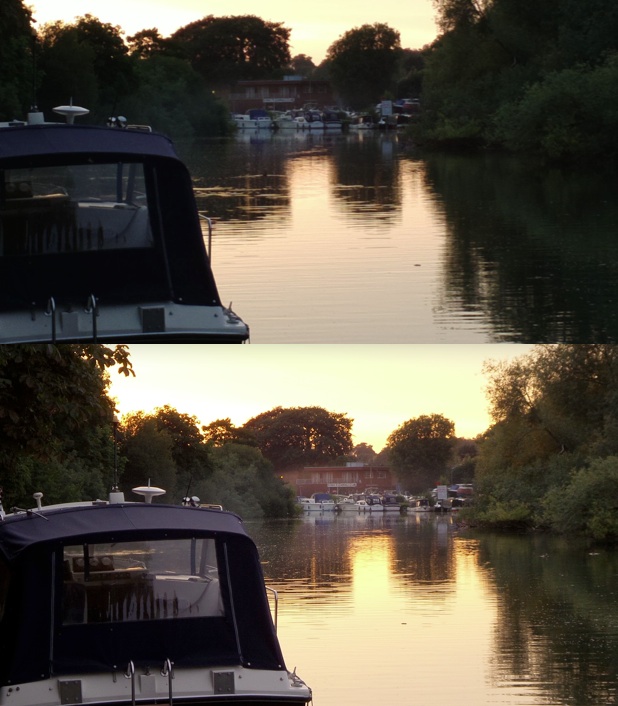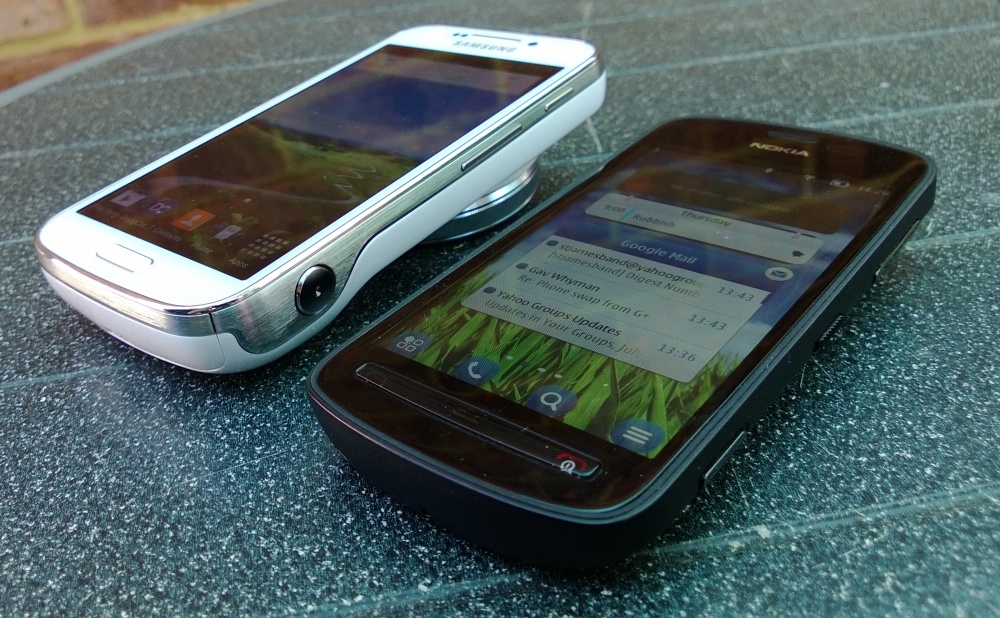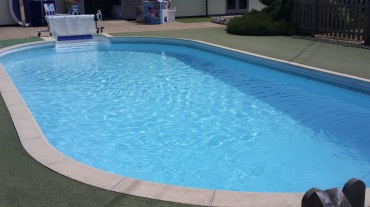Setting the scene
From my intro piece:
Reviewers across the world, unfairly disparaging about Symbian, have remarked how the Nokia 808 is a camera with a phone glued on the back. The Nokia 808 is a lot more than this, as regular readers will know. I'd put the 808 at 30% camera and 70% smartphone. However, Samsung's new hybrid device is around 60% camera and 40% smartphone - it, almost literally, is a physical coupling between a standalone camera and a modern Android smartphone.
Consider the camera specs of the S4 Zoom. It's got the same sensor size as the old Nokia N86, i.e. 1/2.3", yet with a BSI sensor, 10 optical zoom, optical image stabilisation [important for big zoom shots] and a big Xenon flash. Yes, the Nokia 808 PureView has the 1/1.2" sensor, plus the image processing that goes with PureView operations, but it's clear that the Symbian camera champion faces some serious competition here, to say the least.
So, on with this 2013 test, putting the Nokia 808 PureView up against the challenger. And what a challenger:

The S4 Zoom is, it has to be said, chunky - here showing the camera unit turned on and with the zoom lens extended. By comparison, the 808 PureView looks positively skinny(!) It's true that neither of these two smartphones sold (or will sell) in huge numbers, but they do directly compete in my head and in the minds of camera phone enthusiasts everywhere. And yes, the Lumia 1020 will come along in time, to challenge both of these, so you can look forward to that.
___________
Methodology:
- I normally crop down to pixel level, to show up minute differences between exactly competing devices - however, firstly I've had criticism for going in quite so deep when no real world users would do so, and secondly, the differences here are plain enough (in either direction) for me to crop slightly less savagely.
- In addition to the crops, I also include the full original images from each phone, should you wish to check the EXIF data or study the images more closely.
- Each device was largely left on full auto settings (though I agree there's a separate article needed, in taking challenging use cases and seeing how well the creative settings on each would let you cope) and sometimes even on default resolution (5MP vs 8MP, though I did use the creative '8MP' mode half the time for the Nokia 808). And before you complain about resolution mismatch in some examples, it's irrelevant in light of me not going right down to pixel level cropping and because I was using a degree of PureView zoom for almost all the photos.
- In response to suggestions, I did a few comparison tests with other typical 'normal' smartphones with 1/3" sensors, here represented by pop-up appearances by the Nokia N9 and Lumia 920. (And no, I didn't have a Galaxy S4 to hand - I can't do everything, you know!)
- I tried to push the smartphone cameras a little here - no easy snaps, there was almost always something tricky, in terms of light levels, distance of subject, and so on. And in almost all the photos I used some 'zoom', since looking at the differences in performance between PureView and optical zoom was the main aim of the feature.
- As usual, partly for fun, I score the photos/performance as I go along...
Test 1: Full sunlight, arty subject (a swimming pool), 2x zoom
It was fascinating watching the sunlight on the 'blue' water and I wondered what the two devices would make of it. Here are the two shots recorded by the Nokia 808 PureView (left) and Samsung Galaxy S4 Zoom (right), click on either to download the full JPG, if you're interested:
And here's a slight crop of the centre region, looking at detail and artefacts (Nokia 808 on top, Galaxy S4 Zoom on the bottom):

A shining example of how well PureView oversampling works, even when zoomed in a little (so down to only 3 or 4 pixels per 'pure' pixel - the clarity, colour and lack of noise in the 808's image is stunning. This is the device to take holiday snaps with(!) The S4 Zoom's image isn't bad, but there are nasty artefacts where there should be continuous colours, surprising considering how much light was available
Score: Nokia 808 PureView: 10 , Galaxy S4 Zoom: 6
Test 2: Sunset, shooting detail against the sky, 2x zoom
Lovely colours in the sky and the detail of the TESCO sign and clock to pick out for comparison. Again, I zoomed in a little (around 2x), so as to frame what I wanted to see. Here are the two shots recorded by the Nokia 808 PureView (left) and Samsung Galaxy S4 Zoom (right), click on either to download the full JPG, if you're interested:
And here's a slight crop of the centre region, looking at detail and artefacts (Nokia 808 on top, Galaxy S4 Zoom on the bottom):

There really isn't much in this, excellent photos from both phones - the S4 Zoom's image is crisper, partly due to the OIS kicking in and partly because of the usual Samsung edge enhancement algorithms. Most people would pick the bottom crop as the best, perhaps erroneously. But honours even, I can't call a winner here.
Score: Nokia 808 PureView: 9, Galaxy S4 Zoom: 9
Test 3: Patchy sun/shade, nature/live subject, high zoom needed to get 'close'
OK, so no human subject would pose for me, but I did like this duck, standing tall, I was shooting from about 3 metres away, partly hidden behind some shrubbery. Here are the two shots recorded by the Nokia 808 PureView (left) and Samsung Galaxy S4 Zoom (middle), followed by a comparison shot from the Lumia 920 (here representing the 'normal' smartphone camera, remember). Click on any to download the full JPG, if you're interested:
And here's a slight crop of the centre region, looking at detail and artefacts (Nokia 808 on top, Galaxy S4 Zoom in the middle, Lumia 920 on the bottom):

This is where photo comparisons start to get tricky - in truth, each of the phone cameras did an OK job, without excelling. The Nokia 808's image is supremely 'natural', it looks like a window through onto the actual scene, though the image was darker than in real life, plus I couldn't zoom in anywhere near the amount I wanted to, while the S4 Zoom's 10x optics manage to get a lot 'closer' and resolve a lot more detail on the subject, with the downside that it looks artificial in terms of colours and contrast. Meanwhile the Lumia 920's camera, with digital zoom, didn't do that a bad job and some people might even pick the heavily processed image as the overall winner - though there are just too many digital artefacts for my liking.
Score: Nokia 808 PureView: 7, Galaxy S4 Zoom: 7
Test 4: Full sunlight, boat scene, full zoom
I was standing at the lock and a boat was mooring up around 60 metres away - aha, detail that's worthy of an extreme zoom test. Obviously massively skewed towards the 10x optical zoom of the S4 Zoom, but worth exploring anyway. Here are the two shots recorded by the Nokia 808 PureView (left) and Samsung Galaxy S4 Zoom (right), click on either to download the full JPG, if you're interested:
And here's a slight crop of the centre region, looking at detail and artefacts (Nokia 808 on top, Galaxy S4 Zoom on the bottom):

An excellent example of why optical zoom works better in most situations - just look at the difference in clarity and quality here. The Nokia 808, at maximum 3x PureView zoom, is down at the pixel level, with no oversampling, which is why there is lots of noise. Plus, this also comes down to the difference between 3x and 10x zoom. Simply no contest, though as I shall chat about in the third part of this feature, that 10x zoom comes at a significant price in terms of form factor and convenience.
Score: Nokia 808 PureView: 3, Galaxy S4 Zoom: 10
Test 5: Dusk, poor light, distant hot air balloon, maximum zoom
OK, one more shot tailor made for the Galaxy S4 Zoom, I spotted a balloon about a mile away, though I was curious as to how effective the optical zoom 'tunnel' would be in such low light. Here are the two shots recorded by the Nokia 808 PureView (left) and Samsung Galaxy S4 Zoom (right), click on either to download the full JPG, if you're interested:
And here's a slight crop of the centre region, looking at detail and artefacts (Nokia 808 on top, Galaxy S4 Zoom on the bottom):

As with the boat example, there's a big difference between the two zoom levels, though in this poor light you can start to see noise and uncertainty creeping into the S4 Zoom's image. Srill impressive to get all that colour and patterning, plus the two people in the basket, at this distance, at dusk though. In truth, the 808 doesn't do a bad job - my naked eye couldn't make out the colours or patterns at all.
Score: Nokia 808 PureView: 5, Galaxy S4 Zoom: 9
Test 6: Indoors, artificial lighting, slight zoom
Time to stay away from extreme zooms, I think. This was a store scene, with fluorescent lighting and plenty of detail to admire. I zoomed in a little, i.e. 'framing' the shot I wanted more precisely, but there was still plenty of 'PureView' oversampling available for the Nokia 808 sensor. Here are the two shots recorded by the Nokia 808 PureView (left) and Samsung Galaxy S4 Zoom (right), click on either to download the full JPG, if you're interested:
And here's a slight crop of the centre region, looking at detail and artefacts (Nokia 808 on top, Galaxy S4 Zoom on the bottom):

Again a terrifically natural shot from the 808 PureView. It's a hallmark of '808' images that they look as if you're seeing the actual scene rather than a 'photo'. The S4 Zoom's version isn't quite colour-accurate, plus there's noise, as you can see from the pricing strip. Plenty of detail though, so not too far behind the 808.
Score: Nokia 808 PureView: 9, Galaxy S4 Zoom: 7
Test 7: Bright ambient light, in a garden centre, colourful semi-macro, 2x zoom
Pallets of fruit and veg are a camera shoot out staple, of course, and I couldn't resist these tomotoes. A little zoom was needed on both phones, to frame the pallet properly and to achieve a good focus. Here are the two shots recorded by the Nokia 808 PureView (left) and Samsung Galaxy S4 Zoom (right), click on either to download the full JPG, if you're interested:
And here's a slight crop of the centre region, looking at detail and artefacts (Nokia 808 on top, Galaxy S4 Zoom on the bottom):

Quite a difference in terms of colouration here. The Nokia 808 photo is perhaps a little too red, the tomatoes weren't quite this luscious, but they certainly weren't as pale as in the photo from the S4 Zoom. Detail is good in both, but you'd probably fancy eating the 808's version, right?
Score: Nokia 808 PureView: 9, Galaxy S4 Zoom: 7
Test 8: Ultra low light, no zoom
This is a raw test of light gathering ability (and OIS) - flash is turned off and the subject is only about 70cm away, we're looking for detail where by all rights there shouldn't be much - it was so dim in the room that my eyes couldn't pick out colours at all. Here are the two shots recorded by the Nokia 808 PureView (left) and Samsung Galaxy S4 Zoom (middle), followed by a comparison shot from the Lumia 920 (here representing the 'normal' smartphone camera, remember). Click on any to download the full JPG, if you're interested:
And here's a slight crop of the centre region, looking at detail and artefacts (Nokia 808 on top, Galaxy S4 Zoom in the middle, Lumia 920 on the bottom):

This is really pushing the sensors of each camera phone as far as possible. Unsurprisingly, given by far the biggest sensor and despite the absence of OIS to keep the low light shot steady, the Nokia 808 nails it - its image looks dark, but it far more accurately reflects the real life conditions. The S4 Zoom and 920, both with OIS, manage to keep the shutter open longer and, as a result, produce results that are far too light and, oddly, differently coloured. For reference, the actual colour of the wall is a very light lilac, so I guess the 920 got closer than the S4 Zoom, though the image wasn't as crisp, despite the 920's OIS.
Score: Nokia 808 PureView: 8, Galaxy S4 Zoom: 6
Test 9: Party shot, dim/point lighting, flash needed, fully moving subject, 2x zoom
The number one problem situation for most smartphone cameras today, low light and moving human subjects, whether kids in a living room or friends down the pub or at a party. The ultimate test of Xenon flash and camera quality - I've made it harder than I usually do here by shooting from 3.5 metres away, with 2x zoom. In other words, imagine you're at an evening event and you want to snap a friend on the next table or in the next group. They're (as I was here) moving, laughing and there's no concept of posing. There's zero chance of getting a good shot with an iPhone or normal Android smartphone etc - the zoom and the flash requirements rule this out. Here are the two shots recorded by the Nokia 808 PureView (left) and Samsung Galaxy S4 Zoom (middle), followed by a comparison shot from the Nokia N9 (here representing the 'normal' smartphone camera with LED flash). Click on any to download the full JPG, if you're interested:
And here's a slight crop of the centre region, looking at detail and artefacts (Nokia 808 on top, Galaxy S4 Zoom in the middle, N9 on the bottom):

Xenon flash for the win, of course - 3.5 metres is right on the limit of the Nokia 808's range, but it still manages to get a decent, and perfectly frozen image. The S4 Zoom has a stronger (think standalone camera strength) Xenon flash and manages to light the scene as perfectly as might be expected, even from this range, while the N9 mimics what an iPhone or traditional Galaxy or Xperia would produce, with weedy dual LED flash not being able to get near to coping at this range, plus it's typically blurred due to subject movement. (Note that the slight focus differences between 808 and S4 Zoom shots are discounted here, since I was having to rely on the phone's self-timer and auto-focus!)
Score: Nokia 808 PureView: 8, Galaxy S4 Zoom: 9
Test 10: Dusk, river scene, 2x zoom
Let's finish off with a traditional scene, while out and about on a river walk. Here are the two shots recorded by the Nokia 808 PureView (left) and Samsung Galaxy S4 Zoom (right), click on either to download the full JPG, if you're interested:
And here's a slight crop of the centre region, looking at detail and artefacts (Nokia 808 on top, Galaxy S4 Zoom on the bottom):

Hard to pick a winner again here, with both shots satisfying - the 808's again looks slightly more natural, while the S4 Zoom's image is (artificially) slightly sharper and with slightly higher exposure. Let's finish the shoot out with honours even again.
Score: Nokia 808 PureView: 8, Galaxy S4 Zoom: 8
________________
Verdict
As ever, it's instructive to add up the scores, which are very, very close: Nokia 808 PureView: 76/100, Samsung S4 Zoom: 78/100. Giving the overall win very slightly to the Android-running S4 Zoom, though as I'll explain in the third part of this feature, beating the Nokia 808 even by this small margin comes at something of a huge price in terms of bulk and form factor. It's actually a big compliment to the 808 that Samsung have had to go this far into standalone camera component territory in order to finally pull ahead of the Symbian phone.
In terms of the strengths of each device, it's clear that the Nokia 808 PureView wins every time when no zooming is involved, but that optical zoom beats PureView zoom every time once the level gets near 3x or beyond. Which is as expected - physics usually wins, as I've been saying about the Nokia 808 sensor for ages, in comparison to other tiny-sensored phones like the iPhone and Xperia Z. However, with the S4 Zoom we have a device which, in one respect at least, manages to out gun the 808 in terms of physics, with its huge optical zoom.
More analysis and commentary from me on this oddball camera phone pairing next week. In the meantime, comments welcome!
PS. Please don't keep asking for a comparison with the new Lumia 1020 - that's weeks, if not months away, yet, in terms of review hardware. I'll get to that device when the time comes, fear not...
PPS. Thanks to Clove Technology for helping make this feature possible.
























